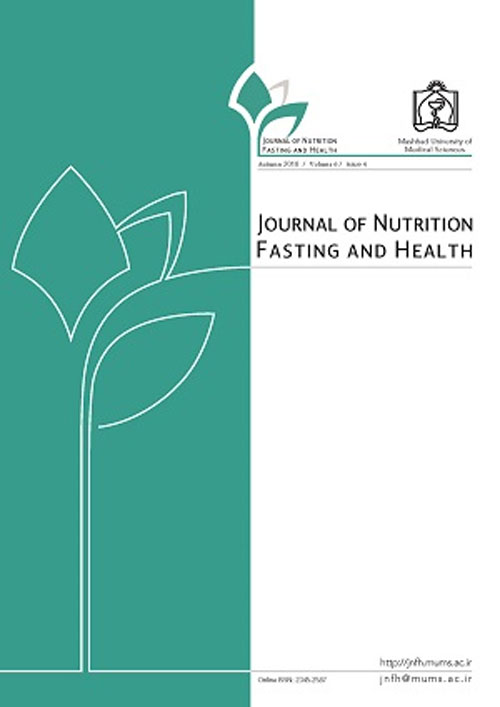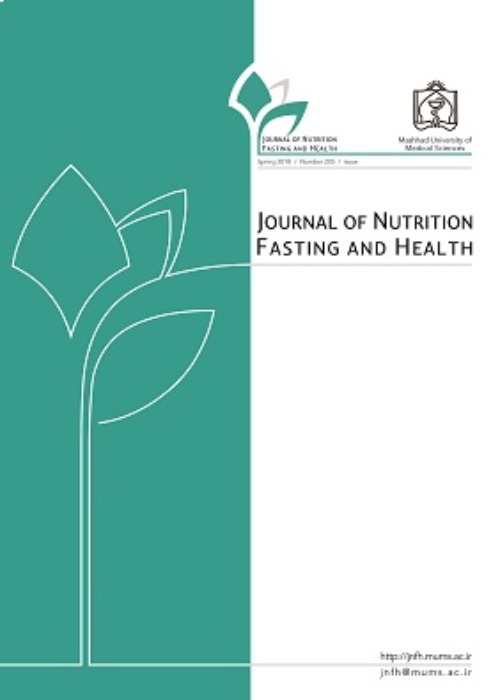فهرست مطالب

Journal of Nutrition, Fasting and Health
Volume:6 Issue: 2, Spring 2018
- تاریخ انتشار: 1397/01/06
- تعداد عناوین: 8
-
-
Pages 60-70Background-Fasting, the voluntary abstention from all restricted foods, is a feature of many religions, and the putative health benefits have attracted both scientific and popular interest. There is no clear understanding that religious fasting has great effects on metabolic syndrome. There is little data available that provides information concerning Ethiopian Orthodox Christians fasting influence on metabolic syndrome indices and serum electrolytes to date.Objective-To determine the effect of ‘Abiy tsom’ (lent fasting) of Ethiopian Orthodox Christians on metabolic syndrome indices and serum electrolytes in Addis Ababa, EthiopiaMethodology- 88 Study subjects were included conveniently who were followers of Ethiopian Orthodox Christianity faith and fasting “lent” and longitudinal cross-sectional study design was employed. Data were collected twice, the first during last week of the fasting months and the second during the last week of two months’ time after returning to usual diet. The data and sample were collected, analyzed, interpreted and was displayed by using descriptive and analytical statistical methods.ResultsOur study found that Ethiopian Orthodox lent fasting had clear and significant effects on Anthropometric measurements, systolic blood pressure, lipid profiles, and Urea. It was also found that this fasting decreased the levels of Calcium and Chloride ions while Serum sodium and potassium were influenced insignificantly.ConclusionEthiopian Orthodox Christians lent fasting is beneficial for weight loss and fighting metabolic syndrome.Keywords: Ethiopian Orthodox Christians, lent fasting, metabolic syndrome, serum electrolytes, Ethiopia
-
Pages 71-83IntroductionAflatoxins are secondary fungal metabolites produced by Aspergillus fungi, in particular Aspergillus flavus, Aspergillus nomius and Aspergillus parasiticus. Aflatoxins have undesirable effects on human and animal health and lead to various diseases, including liver disorders. Four main types of aflatoxin are B1, B2, G1 and G2, and aflatoxin M1 and M2 are metabolites derived from aflatoxins B1 and B2.Materials and MethodsIn this paper, studies on aflatoxin contamination in different foods were investigated. Keywords for related articles include: Aflatoxin, Iran, Incidence, Food, Oil, Milk and Dairy Products. Articles were obtained from SID, Science direct, PubMed and Google scholar databases. Abstract of all related articles were reviewed and finally, articles which mentioned to the amount of aflatoxin were selected.ResultsResults showed the presence of aflatoxins in most of the tested food. In most studies conducted on milk and various dairy products, the level of aflatoxin was higher than the recommended level set by the Institute of Standards and Industrial Research of Iran and the European Union.Conclusion(s)Practical management and control strategies are necessary for assurance of the safety of consumers regarding aflatoxin residue in different foods in Iran.Keywords: Aflatoxin, Iran, Food, Milk, dairy products
-
Pages 84-87IntroductionThe aim of present study was to assess the correlation between glucose and lipid biomarkers variations with biometric characteristics and intraocular pressure changes following Ramadan fasting.MethodsA total of 100 healthy fasting volunteers were enrolled in the study. Of them, 89 subjects completed the study with respect to inclusion and exclusion criteria. Right eye ocular axial length and anterior chamber depth were determined using the IOLMaster, (Carl Zeiss Meditec, Jena, Germany). Following that, intraocular pressure of right eye was measured using a non-contact tonometer (Topcon, Computerized Tonometer CT-1/CT-1P, Tokyo, Japan). Blood samples were taken from all the participants and concentrations of the biomarkers, including Fast blood sugar, Triglyceride, Cholesterol, High-density lipoprotein and Low-density lipoprotein were measured using the Hitachi 717 analyzer (Hitachi, Tokyo, Japan). All assessments were obtained one week before and after Ramadan.ResultsOf 89 healthy Muslims who complete the study, 51 were men (mean age: 35.51±8.94 years) and 38 were women mean age: 34.26±9.41 years).The results indicated no significant relationship between the axial length with glucose and lipid biomarkers variations in the fasting individuals. The assessment of result showed only a slight correlation between anterior chamber depth and High-density lipoprotein changes during Ramadan, however, this was not statistically significant. Also, findings revealed only a slight correlation between intraocular pressure and cholesterol changes in healthy fasting individuals, however, this was not statistically significant.ConclusionOur study revealed that ocular parameters changes during Ramadan fasting is probably independent to variation levels of glucose and lipid biomarkers.Keywords: Biomarkers, Axial length, Anterior chamber depth, Intraocular pressure
-
Pages 88-98IntroductionIn today's world, “It is believed that use of microbial agents and biological toxins are harmful for human health. Food industry is a soft target and potentially vulnerable to deliberate contamination. The manufacturing units of dairy industry are a good example. The purpose of this study was to determine the level of food defense preparedness of dairy production units using FDA Food Defense Assessment Checklist.MethodsIn this descriptive cross-sectional study, Persianversion of checklist was prepared usingbackward-forward translation method and evaluated for its face and content validity by the panel of experts. Content validity index (CVI) and content validity ratio (CVR) of all items were calculated. After the localization of the study tool, 39 dairy producers entered the study.ResultsAfter modifying checklist based on validity assessment and localization, the number of questions reduced from 34 to 31. The level of food defense preparedness in dairy producers in terms of management, human element, facility, and operations were 38.3%, 45.5%, 67.7%, and 92.1% respectively. The only item in the checklist that was seen in all evaluated units was the existence of an initial assessment plan for the adequacy of food security procedures to prevent the deliberate contamination.ConclusionThe results of this study showed that food defense preparedness of large-scale dairy producers was not ideal and it was determined impractical in many items. Hence, further studies are required to determine its cause and then take the necessary steps to enhance the level of preparedness.Keywords: Validity, intentional Contamination, FDA, Dairy, Preparedness
-
Pages 99-103BackgroundThe use of a neutropenic diet after hematopoietic stem cell transplantation (HSCT) was instituted more than 30 years ago. This diet was targeted toward preventing from infection with organisms colonizing the gastrointestinal tract and the food-borne pathogens, which are the most important cause of illness and death in developing countries. Regarding this, the present study aimed to evaluate neutropenic diet in patients undergoing bone marrow transplantation in a selected hospital. This study also sought to investigate the role of hospital foods in the transmission of clinically important bacteria to the hospitalized patients.Materials and MethodsThis cross-sectional study was conducted on the specimens of the foods served in the Bone Marrow Transplant Department of Shariati Hospital, Tehran, Iran. The samples were evaluated in terms of bacterial contamination using the standard method of American Public Health Association and Food and Drug Administration (FDA).ResultsAccording to total bacteria and coliform counts, No contamination was detected in any of the tested specimens.ConclusionAs the findings indicated, the neutropenic diet, was found to be fully in line with the standards of the Ministry of Health and FDA both in terms of guidelines and food analysis.Keywords: Bacterial contamination, Food-borne, Hematopoietic stem cell transplantation, Neutropenic diet
-
Pages 104-106Fasting effects on health and well-being. Although this effects were studied based on biological view, however there is a different view based on our Islamic teachings. Fasting is related to human virtues such as piety and cautious. These virtues are related to others characteristics in Islamic view which show the holistic view of Islam on health. In order to answer this question refer to Holy Qur’an which says in Chapter 2, Verse 183: ‘Believers, fasting is decreed for you as it was decreed for those before you; perchance you will be cautious’. As this verse shows fasting is related to piety and cautious. Here, the main function of fasting is not health but is another function which is piety. Therefore, fasting effects on health indirectly. As Fig.1 shows fasting alongside with other Muslim behavior such as attending Masque, daily Prayer, reading Qur'an, Devotion & Surrender, and Pilgrimage (HAJ) effect on several things. Human virtues such as forgiveness, honesty, self- discipline, altruism, generosity, humility, gratefulness, patience and dependability are affected by them. As we know these characteristics are important for being a healthy man. These items effect on all dimensions of health which are physical, psychological, social, and spiritual. Therefor piety leads to a features such as hope, contentment, patience and not being greedy. These characteristics leaded to our health and well-being generally. Theoretical and practical debates is recommended.Keywords: fasting, Islam, Holism, virtue
-
Pages 107-114IntroductionNon-alcoholic fatty liver disease (NAFLD) is a clinical pathologic condition, which leads to inflammation events in hepatocytes. The objective of present study was to compare the plasma levels of VEGF and sVEGFR-1 as inflammation factors in overweight and obese children and adolescents with and without NAFLD.Materials and MethodsA total sample of 70 overweight and obese children and adolescents (37 boys and 33 girls) were recruited from those admitted to a nutrition clinic in Mashhad, northeastern Iran. The presence of NAFLD was determined by FibroScan, ultrasound and elevation of liver enzyme. Plasma VEGF and sVEGFR1 were also determined for each individual.ResultsVEGF levels (log transformed) showed a significant stepwise increase from “zero” to “first”, “second” and “third” grades (P trend<0.001). However, sVEGFR1 (log transformed) did not show a regular trend between different grades of NAFLD (P trend=0.3). The odds ratios (95% confidence interval) for VEGF across categories of NAFLD were 1.00, 0.99 (0.97-1.01), 1.02 (0.99-1.04), and 1.04 (1.02-1.06). The odds ratios remained relatively unchanged even after adjusting for sex, age and BMI.ConclusionThis study showed a significant positive association between plasma VEGF levels and grades of steatosis in overweight and obese children and adolescents, even after adjustment for age, sex and BMI.Keywords: Non-alcoholic fatty liver disease, VEGF, sVEGFR1, children, adolescents
-
Pages 115-121IntroductionDiabetes is the most typical metabolic disease simultaneous with pregnancy. Preeclampsia is the most common disorder which accompanies gestational diabetes. Recent studies demonstrated the role of micronutrients in women with diabetes which accompanies preeclampsia. The aim of this study was comparison between micronutrients in gestational diabetic hypertensive women with and without preeclampsia.MethodologyIn this descriptive research, 72 gestational diabetic hypertensive women with and without preeclampsia participated who were in the third trimester of pregnancy. Demographic information and previous and current pregnancies data was filled in the questionnaire. Then a blood sample was taken and micronutrients include iron, zinc, magnesium and lipid profile was measured. Data analyzed by using SPSS version 19 and statistical method include T-test, and chi square. The value less than 0.05 were considered as significant.ResultsOf 72 participants 32 cases were gestational diabetes and hypertension with preeclampsia and 40 women without preeclampsia. Iron level in the group with preeclampsia was 108.91± 64.58 and in the group without preeclampsia was 79.75±53.33. The level of in the group with preeclampsia was 65.73±24.40 and group without preeclampsia was 53.17±19.23. The level of in group with preeclampsia was 220.59±61.92 and in group without preeclampsia was 192.83±47.46. Differences between two group for iron (P=0.39), zinc (P=0.02) and copper (P=0.035) was significant .Magnesium’s level and Cholesterol and triglyceride in two group were similar without significant differences (p>0.5)ConclusionMicronutrients include iron, zinc and copper in gestational diabetic hypertensive women with preeclampsia has been higher than gestational diabetic hypertensive women without preeclampsia.Keywords: Iron, zinc, magnesium, Copper, lipid profile, preeclamsia, Diabetes


